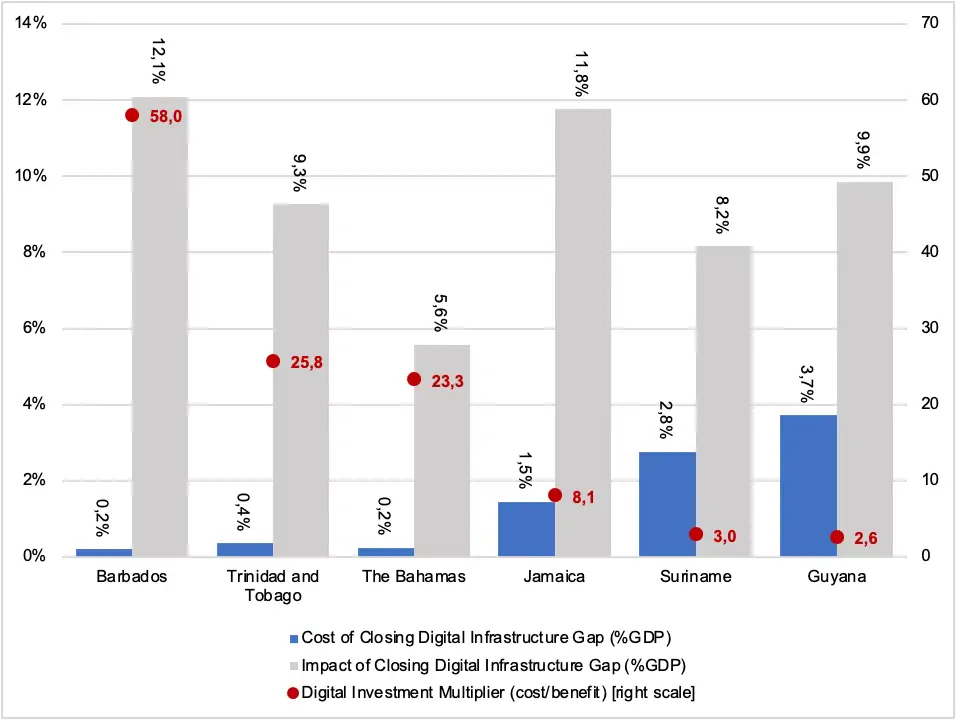
Closing the digital access gap between the Caribbean and the more advanced economies could increase the region’s GDP by about 6 to 12 percent over the medium term and provide a strong boost to a post-COVID-19 recovery, according to a new report by the Inter-American Development Bank.
The Regional Overview: Digital Infrastructure and Development in the Caribbean is part of the IDB’s Quarterly Bulletin economic series. In addition, it has economic sections for Suriname, Jamaica, Guyana, Trinidad and Tobago, The Bahamas, and Barbados.
The report looked at economic growth in the region, with a focus on productivity – a key driver of long-term economic growth and an opportunity for the Caribbean to get to the level of similar economies across the world.
“Access to faster internet is more than just streaming Netflix and Zoom calls,” said David Rosenblatt, the Regional Economic Advisor for the IDB’s Caribbean Department. “For the Caribbean, a modern and robust digital and telecommunications infrastructure is a connection with powerful global trends that are driving growth. It is the key to unlock faster productivity growth for decades to come.”
The payoffs of investing in digital infrastructure are large, the report notes, with potential GDP gains that range between 2 times and nearly 50 times the estimated costs.
Digitalization is one of the critical areas that would allow the region to close development performance with comparable economies., Caribbean economies have experienced volatile growth rates over the past five decades, averaging under 1 percent or negative growth for long stretches, are vulnerable to global economic shocks and, have been hard hit by the COVID-19 pandemic.
Figure. Estimated GDP and Productivity Gains from Closing Digital Infrastructure Gaps in Latin America and the Caribbean (percent)

Source: Authors’ calculations based on gaps from Table 1 and elasticities from Zaballos and López-Rivas (2012).
The report includes estimated fixed and mobile broadband gaps between countries and advanced economies grouped in the Organization for Economic Cooperation and Development. For instance, Trinidad and Tobago has a fixed broadband gap of 9.2 percentage points against the OECD, The Bahamas’ gap is 11.2 percentage points, and Jamaica’s 24 percentage points. Except for Uruguay, all Latin American and Caribbean countries have positive gaps relative to the OECD.
The authors used an econometric model to estimate the benefits of closing the digital infrastructure gap. A 10 percent point change in digital infrastructure is associated with a 3.2 percent higher GDP and 2.6 percent higher productivity over a six-year period. For nearly half of Caribbean economies, digital investments could yield cumulative GDP increases in double digits, which the report calls “transformative improvements.”
When looking at cost-benefit ratio – the so-called “multiplier effects”– of infrastructure investments, the report found that for The Bahamas, Trinidad and Tobago, and Barbados the potential benefit in terms of the cumulative positive impact on growth could be between 23 and 58 times the associated costs.
Benefits versus Costs of Closing Digital Infrastructure Gaps in Caribbean Countries (percent of GDP and multiplier)

Source: Authors’ calculations based on data from the Table 1, Zaballos and Lopez-Rivas (2012) and IMF (2021).
Note: “Gap” refers to the cost of closing the estimated digital infrastructure gap relative to Organization for Economic Co-operation and Development economies. Figures expressed in percentage points are as of the end-2019 GDP. The multiplier is defined as the estimated GDP growth impact of closing these gaps relative to their costs.
Governments can play a big role in facilitating more digital investments, including updating regulatory frameworks for issues such as “rights of ways”, spectrum allocation and universal service funds. The report calls for governments to establish a close relationship between digital agendas and national connectivity plans.
The IDB publishes a Broadband Index Report annually for 65 countries, looking at public policies, regulations, infrastructure, and application and training. While some Caribbean economies rank high when compared to Latin American countries, the report notes, it lags with lead countries such as Sweden, the United States, India, Iceland, and Australia.
“If this recent crisis has taught us anything, it is that the ability to communicate, transact, and reach clients and markets virtually has never before been more critical,” the report says. “The future will reward economies that can do so most effectively.”

